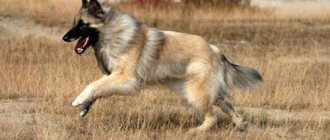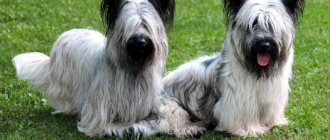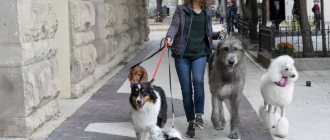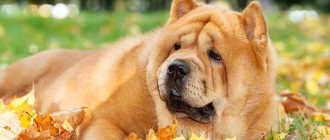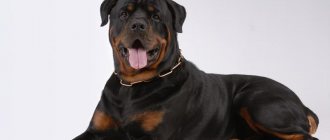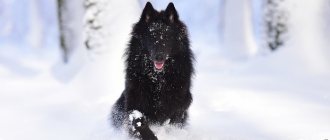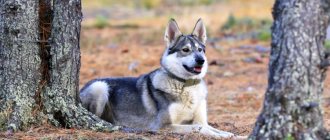These are excellent defenders and guards.
They are devoted to their owner, but not everyone can raise a dog correctly.
In order to prevent irreparable mistakes in training, you need to know the breed’s character traits and difficult periods in education.
This breed is devoted to its owner, it can and should be trained.
History of the origin of the breed
This breed is considered one of the most ancient; their ancestors were Molosser dogs. They accompanied legionnaires back in the days of Ancient Rome.
The Rottweiler breed itself originated in the German town of Rot Weil in the eighteenth century.
Being descendants of the ancient Roman dogs - Molossians, Rottweilers were larger, had a more docile character and were very easy to train.
Previously, Rottweilers were harnessed to carts; the dogs were used to transport small loads. Moreover, Rottweilers were not only carriers, but also excellent guards. Today, photos of a Rottweiler can be found on the Internet.In 1921, the United German Rottweiler Club was created, which is of the unanimous opinion that these dogs should still remain working dogs.
Historical reference
It is no longer possible to establish from which region the Rottweiler dog came to Germany. There is an assumption that the number of coal-black Molossians that have settled throughout Europe is the “legacy” of the Tibetan Mastiff. According to another version, the ancestors of the Rottweiler are the dogs of the Phoenicians and local aboriginal dogs. Experts also said that the Rottweiler descended from Roman fighting dogs. Another hypothesis states that the breed also comes from Rome, but from herding four-legged animals. In fact, all possible versions of the origin of the modern Molosser are listed above and each of them is viable.
This is interesting! Historical data mentions dogs very similar to Rottweilers that participated in the Seven Years' War (one of the largest territorial conflicts of the 18th century).
There is also a very interesting fact confirming the presence of hostile Romans in Germany. Moreover, the story describes in detail how important the four-legged role was played in the campaign. Mention is made of battles in which angry dogs clad in chain mail run in front of a line of soldiers, brave, unshakable, with the desire to die, but not to retreat. If we transfer this historical characteristic to modern Rottweilers, there are no contrasting differences to be found.
In the homeland of the breed, conflicts have flared up more than once; hostile peoples have attacked peasants, divided the territory and “torn” it apart. Only one thing remained unchanged: the burned villages were restored, and people again took up cattle breeding. During one of the “revivals”, a church was erected on the site of outbuildings. The walls were demolished, but the floors, paved with red clay tiles, remained intact. According to legend, the town of Rothwil got its name from the phrase “Rote Wil” - red floor. Given the reputation of the church and religion, this “scenario” is accepted even by historians.
As you may have guessed, the Rottweiler dog breed was named after its “native” town , although these four-legged dogs have two homelands. two species of large black dogs lived in the vicinity of the city . Some were more powerful and muscular, they carried heavy loads, but were not suitable for herding. The four-legged animals fell from fatigue during the drive, and when angry, they could seriously harm the livestock. The second species was smaller, tougher, more agile and, as history has shown, smarter.
Rothville developed at a fairly serious pace and soon the city became a “bastion” of butchers. The wider the scale of production became, the more dogs were required, both cattle and draft dogs. The second homeland, which was mentioned above, is the town of Rottenburg , which developed and grew in a direction similar to Rottenburg. The business of cattle breeders was the foundation of the economy; workers of the “honorable industry” even had their own coat of arms with the image of a “butcher dog” - the Rottweiler.
This is interesting! Many of the butchers in Rothville liked to have a sip after work. To be honest, most of the city's male population suffered from severe alcoholism, and drinking often led to rowdy behavior and an empty wallet. To protect their money from themselves and criminals, butchers put cash in special wallets for their Rottweilers. Wealth hung ostentatiously around the dog’s neck, but no one in their right mind would risk robbing the four-legged dog.
The work of butcher dogs was different from ordinary herding. The four-legged one was supposed to bring down the herd, restrain it and take it to the slaughterhouse! Not all animals obeyed, realizing that they were going to certain death. The hardest thing was with adult bulls, whose rage is dangerous for everyone around them. The dog's duties included restraining the rampaging animal and delivering technical bites at the butcher's command.
This is interesting! Butcher and draft dogs were distinguished by the length of their tail; cattle Rottweilers had docked tails.
By the 19th century, Germany was striped with railway tracks, draft dogs were replaced by more hardy and calm donkeys. The features of the breed for which the German Rottweiler was valued for centuries lost relevance, and this led to its collapse. Butchers who were not prone to sentimentality got rid of extra mouths. The breed's population was literally dying out. There is a legend that by 1882 there was only one male Rottweiler left in Rotweiler. In fact, the truth of this statement has not been confirmed. And a version arose after an interbreed exhibition, at which only one butcher’s dog was shown, the purity of which was seriously doubted.
By the time the Germans woke up and decided to restore the breed, only a few Rottweilers remained. There were no breeders willing to do such long and difficult work. An incident that appeared in the media and spread widely throughout Germany in the form of rumors helped. Hamburg, a city that attracts foreigners, was vandalized by a large crowd of drunken sailors. The policemen, fearing for their lives, did not want to get involved in the altercation. Only a young non-commissioned officer (a rank similar to “private”) decided to disperse the crowd, and his service Rottweiler helped him.
It’s impossible - it means it’s impossible
You are engrossed in playing with your puppy, and suddenly your baby starts tearing the wallpaper or biting your hands. This behavior is unacceptable, if you don't stop these actions now, you will face big problems in the future. Leaving your dog alone at home can lead to you returning to the “ruin.” Or you will be constantly afraid that the Rottweiler will bite you.
For such and many other cases, there are prohibition commands: “no”, “fu”. If you want your Rottweiler to stop what he is currently doing, use the "fu" command. Use the “no” command when you forbid your dog to perform an action you dislike once and for all.
Health problems
Rottweilers naturally have excellent health, especially if kept in normal conditions. But, like other animals, they can be susceptible to the following diseases:
- flatulence (bloating);
- articular dysplasia and other joint diseases;
- diabetes;
- obesity;
- eye diseases: retinal atrophy, cataracts, entropion;
- kidney disease;
- diseases of the nervous system.
It is worth noting that many Rottweilers can snore in their sleep. Sometimes this feature leads to coughing. If this happens occasionally, then there is no need to worry. But if the cough persists, it may be a symptom of heart or lung disease.
Rottweiler: characteristics of the breed
Before getting such a pet, it is best to familiarize yourself with what the characteristics of a Rottweiler are.
He has a lot of positive qualities that should be taken into account:
- Rottweilers are very hardy
- They have a strong skeleton
- These dogs have developed muscles
- He is easy to train
- Is an excellent guard
- Great with children
- Highly intelligent
Tips from a dog handler
It should be remembered that Rottweilers have good intelligence and are easy to train. However, there is also a negative side of this breed - it is a slow reaction. Accordingly, a person needs to be patient when it comes to learning.
Attention! You can’t break down, much less beat an animal.
Each task is studied until the dog masters it. A significant advantage is that the Rottweiler will never forget a learned skill and will always perform it.
As you can understand, training is a complex process that requires a lot of dedication from both the dog and the person. If everything is done correctly, the animal will learn the necessary commands and will delight the owner with its obedience.
Rottweilers and their character
They are optimistic, kind and playful sanguines who make great family members and love to play games.
They are incredibly reliable, the best Rottweilers are vigilant towards strangers, if their owner is in danger - they are ready to rush into battle and can be deadly. This dog cannot be bribed or appeased; they are incredibly loyal and devoted.
Rottweilers are dogs that will obey only the strongest owner, who will not be afraid of him and will become a real leader for the pet.
It is not recommended for people with a weak character, a child or a woman to have such a four-legged friend.
If a dog lives in a family in which conflicts constantly occur, he himself can become aggressive and even attack his owners. Rottweilers love children and protect them from any threats, even from peers.
Varieties
The description of this breed is strictly regulated in the standards.
Moreover, today there are 4 of them:
- German;
- American;
- English;
- from the Canine Federation.
It is known that in the USA, when breeding, they often used dogs that were purebred, but defective and rejected in Germany. Therefore, at the origins of their genealogy there were not the highest quality individuals.
In an attempt to improve the protective properties of the Rottweiler, they usually imported representatives of the breed that were slightly more aggressive and tall, which affected the entire line. Such dogs look much more severe than their “European” counterparts.
This practice has led to the appearance of certain genetic diseases in Rottweilers, such as articular dysplasia. If a purebred dog is healthy, this does not make him less aggressive and he also needs proper upbringing.
English Rottweilers are almost no different from the “Germans”, since standard breed parameters were used in breeding. The difference lies only in the character of the dogs. Like true Englishmen, such dogs already from 1 month of life have strong self-control, which can only be broken by the owner’s order.
The original approach to breeding in each individual country led to the emergence of other recognized and unrecognized purebred dog lines, such as Finnish, Austrian, Norwegian, Italian, etc. Each of them has its own minor characteristics caused by the geographical location and desires of the owners.
A purebred dog is allowed only one color: black with orange tan. The golden color of the Rottweiler, or any other color, is considered a departure from the standard. Exactly the same as changes in coat - long-haired dogs are also determined to be defective.
What age is best to start?
Rottweilers begin to be trained from the age of one month . This is the time for name, toilet and leash training.
You need to know that the dog's character will gradually develop in the direction you need. The first months of a puppy's life are raised by a female dog, and he learns basic skills.
As soon as he gets into the house, you already take responsibility..
Read about how Rottweilers grow up here.
Proper care
Description of the Rottweiler breed includes proper care and its main stages.
- It is necessary to comb the coat a couple of times a week;
- You need to bathe your Rottweiler two to three times a year;
- He needs to be vaccinated;
- After a walk, the Rottweiler's paws are washed;
- The pet must be treated for parasites;
- He needs his ears cleaned every week;
- Teeth are brushed once a week.
Tail docking
In the USA, Europe and many Asian countries, tail docking is prohibited. Russia has not joined the convention, and this procedure is legal. The Rottweiler's undocked tail must conform to the standard and continue the line of the back.
Tail docking is not recommended for adult dogs - this is a rather painful procedure for older Rottweilers. Yes, and scars remain if the operation is performed after a year. Tail docking is usually done immediately after birth, when the puppy is between 3 and 10 days old. The permissible period is up to 6 months.
If cupping is carried out on time, there are two ways to do it:
- Bandage - when a tourniquet is applied to 2/3 of the length of the tail, and the tissue dies within a week.
- Surgical - under general anesthesia, the unnecessary part of the tail is cut off.
There is no need for special care for the dog after docking - the bandage is changed every three days until complete healing.
How to train an adult dog to behave outdoors
The most important thing a dog should do outdoors is go to the toilet.
First, you should train your puppy to go to the litter box . Then, when he walks there confidently and without missing a beat, slowly move the toilet towards the door.
When you start walking your dog, take with you a diaper that your puppy usually uses to relieve himself. A familiar smell will help him find his way.
When the dog gets used to the street, remove the tray. Walk your Rottweiler about 5-6 times a day. Over time, he himself will begin to ask to go outside.
If the puppy starts going to the toilet at home and on the floor, then the procedure will have to be repeated . For starters, it’s worth even rewarding the puppy for doing his “business” where he’s supposed to.
Also, in order for the dog to behave calmly during a walk, two to three weeks before the walk, begin to accustom him to a collar and leash.
Be prepared for the fact that your dog's behavior on the street may change, because it is full of new noises and smells.
It is quite possible that the dog will rush after a cat or a cyclist, so first choose deserted places for a walk.
You need to socialize your dog when it already listens to you and follows basic commands.:
- "Walk".
- "Near".
- "Aport."
- "Home".
All puppies are curious and emotional. This means that when walking, the dog will pull you in different directions, trying to absorb as much information as possible.
In this case, try to keep the dog near you, control his impulses . Do not forget to repeat the prohibition commands, while pulling the leash toward you, pulling the dog closer to your feet.
Make sure your puppy doesn't pick up trash from the ground.
When you are sure that your dog will listen to commands, start visiting dog parks so that he can communicate with his brothers.
If this is not done, then when meeting other dogs, the dog will rush at them, behave aggressively, or, on the contrary, be afraid . It is important that he knows that he is not the only dog in the world.
Appearance
Let us immediately note that the FCI and ADRK standards differ slightly in wording, but since the organizations closely cooperate, the meaning of the descriptions is similar. If you are little familiar with the characteristics of the breed, then you should focus on the FCI standard, since it is intended for a wide circle. The characteristics of the breed are impressive and contrast with the attributed “horror stories” - straightforward, proud, excellent with children, calm, with a stable psyche, attentive, easy to train and controllable dog.
At first glance, the Rottweiler is a large or very large dog with strong bones, well-developed muscles, not too long and confidently set paws, a strong but not rough head. The weight indicated in the standard is interpreted as approximate; when assessing, height and proportions in relation to it are more important:
- Male : 50 kg; permissible height 61–68 cm; optimal height 65–66 cm.
- Female : 42 kg; permissible height 56–63 cm; optimal height 60–61 cm.
Important! The main proportion that is taken into account when assessing is body length to height at the withers; it should not exceed this figure by more than 15%.
Breed standard
- The head is strong, but not heavy. The forehead is wide, moderately convex, divided by a shallow groove. The back of the head is wide, but not convex. The transition to the muzzle is well defined. The top line of the front part is flat. The muzzle is equal in length to the frontal part, tapering towards the nose, but not pointed. The muscles of the head are well developed, the silhouette is emphasized by wide cheekbones. The lips are of medium thickness, not too tight, but not droopy. The corner of the lips is closed, the edges are completely black. The end of the muzzle is “chopped off”. The palate and gums are extremely pigmented and dark.
- The teeth are complete, large, even. Scissor bite, without gap. Both jaws are wide and strong.
- The nose is only black, slightly elongated in shape with well-developed nostrils.
- The eyes are almond-shaped, proportional in size, with black rims on the eyelids. The irises are brown, as rich and dark as possible.
- The ears are semi-erect, turned forward, triangular with rounded tips, medium in size, high and wide set. When viewed from the front, the line of the ears visually expands the silhouette of the head.
- The body is strong, powerful, when the dog is standing, a rectangle fits. The neck is wide, muscular, of medium length with a bend. The dewlap and folds at the neck are a drawback. The sternum is voluminous, the depth is approximately equal to 1/2 of the height at the withers, the forebreast (the front part of the keel bone) and the ribs are developed, convex, and powerful. The withers are developed, massive, turning into a wide, level and very strong back, the loin is muscular, the croup is rounded. A croup that is sloping or too straight is a serious fault. Groin free.
- Limbs - the front legs are set wider than the lines of the body , smooth, wide and strong. The shoulder blades are inclined at 45°, the shoulders are wide, the forearms are powerful and adjacent to the sternum, the elbows are also pressed to the chest, not turned out or collapsed, the pasterns are springy and strong, set at an angle to the ground. The hind legs are slightly pulled back , set wide and confident. The thighs are not elongated, wide, the legs are elongated and well muscled, the hocks are flexible and strong , set at an angle to the ground. The brushes are round, collected, arched. The hind toes are slightly longer than the front.
- Tail – docked short or natural, without knots or kinks . Extends the line of the back, carried low (at rest) or at the level of the back.
How to feed a Rottweiler?
Fifty percent of the menu should consist of proteins, so his diet must certainly include:
- Cottage cheese and cheese
- Meat and fish
- Eggs
- Porridge (rice, buckwheat and oatmeal)
You can feed your pet dry food, but in order for the dog to be in excellent shape, you need to choose only expensive types of food that contain all the necessary elements and minerals, but a natural diet is still preferable.
Exhibition training
The dog is prepared for exhibitions from the age of 2-3 months. In most cases, an inexperienced trainer will not cope with the task, since the animal must:
- treat large crowds of people and other dogs calmly;
- run next to the owner for a designated number of laps;
- stand up on demand;
- allow yourself to be examined by judges and experts.
Behavior at exhibitions
Choosing a puppy
You need to buy a Rottweiler while still a puppy. This will ensure normal mental development of the animal. The recommended age for purchasing this breed is 1-3 months.
When examining a dog, before purchasing, you need to pay attention to the following nuances:
- the umbilical hernia does not protrude;
- clean ears and eyes;
- drooping testicles in a male dog;
- absence of dandruff and hair defects;
- pink skin on the belly and gray or silver on the back.
Rottweiler price
How much does a Rottweiler cost? This is influenced by the presence of a pedigree. The price range is very wide and can range from 10,000 to 30,000 rubles and above.
The price is also affected by whether the puppy has titled parents and what its exhibition prospects are.
Training scheme
Two months: training to go to the toilet in a diaper, training to use a collar and leash, beginning to practice simple commands.
Three months: learning to eat what you give, and not picking it up from the floor, accustoming him to using the toilet outside, continuing to learn simple commands.
Four to five months: full training.
Learning the commands “Come”, “Place”, “No”, “Sit”, “Lie down”, the dog should stop barking on demand.
Six months: learning more complex commands, beginning to prepare for the dog’s protective guard duty.
Seven months or more: consolidation of learned skills.
CAREFULLY!
Training a Rottweiler must be appropriate to its age and skills, otherwise the dog's intelligence will stop developing and it will become disobedient.
Basic mistakes in parenting
Raising a Rottweiler correctly, without making mistakes, is very difficult. Especially if, on the one hand, there is a novice dog breeder, and on the other, a puppy or an adult Rottweiler.
An owner who adopts a dog must be prepared to educate himself.
Here are some common mistakes that owners make when raising Rottweiler puppies or older pets:
- Under no circumstances should an animal be punished when called. When a pet runs up to its owner when called or at will, the owner is obliged to forget what he was going to scold and punish the dog for. There is no need to praise a four-legged animal if it approaches its owner after an offense, but it is also unacceptable to punish it.
- Taking out anger and bad mood on a puppy is unacceptable. A person must be able to control emotions. If your pet has misbehaved, it is necessary to punish him. Punishment is an instruction, not a release for the owner’s feelings.
- It is necessary to punish a pet only after catching it directly at the crime scene. Otherwise, the dog simply won’t understand why. And over time, he will stop trusting his owner because of such punishments for no reason.
- When raising a puppy, the owner must be consistent in his requirements. Punishment should always be done when necessary.
- Sometimes the strict command “Fu!” it will be enough for the animal to correct itself. Do not rush to use physical punishment.
- All family members should make the same demands on the dog. Then the result will be stable.
- You cannot demand everything from a puppy at once.
- It is a mistake to think that a grown dog does not need games and entertainment. They are extremely important for the physical development, health and emotional relief of the animal.
- Close contact between the owner and the four-legged pet is the main condition for successful education and training. This applies primarily to Rottweiler owners.
Deviations from the standard
Standard sizes
The FCI standard states that the height of male Rottweilers varies from 61 to 68 centimeters, and the height of females varies from 56 to 63 centimeters. According to these parameters, it is customary to distinguish dogs of this breed according to the following sizes:
Males:
- small – 61-62 centimeters;
- average – 63-64 centimeters;
- large (optimal size) – 65-66 centimeters;
- very large - 67-68 centimeters.
Bitches:
- small – 56-57 centimeters;
- average – 58-59 centimeters;
- large (optimal size) – 60-61 centimeters;
- very large - 62-63 centimeters.
Dogs that meet standard parameters have a good chance of receiving top marks at shows and giving birth to healthy puppies.
Reasons for deviations
Sometimes dogs are born whose sizes are much smaller than even the small standard ones. The small Rottweiler is not a breed variety, but a consequence of serious abnormalities. They appear due to mistakes in breeding purebred dogs, hereditary diseases or birth injuries. Sometimes these puppies are born because their mother did not eat well during pregnancy or while nursing.
There are cases when unscrupulous breeders, in order to make a profit, attract potential buyers with advertisements for the sale of supposedly mini representatives of the breed. They deliberately breed Rottweilers with much smaller sizes, without warning about the complications that the owner of such a dog may encounter.
Possible problems
When buying a mini Rottweiler, you will have to come to terms with many problems that such dogs are sure to bring. Dwarf animals usually do not live long. And not only because of genetic predisposition.
Such individuals have a weakened immune system, so they are susceptible to frequent diseases. Such dogs can even die from anesthesia, which may have to be used in the treatment of one of the diseases. Their bones are very fragile and often break. The owners will have to constantly look after their mini pet.
Owners of small dogs will have to come to terms with the fact that their pets will never participate in exhibitions or breeding. It is generally better to castrate or sterilize such animals. Especially bitches. Their body may not be able to withstand the load that pregnancy brings.
Small dogs usually have impaired functioning of the nervous system. You should not expect the usual calmness that standard dogs of this breed possess from mini Rottweilers. After all, dwarf dogs do not adapt well to the world around them and are subject to constant stress. Therefore, such children are often mentally disturbed and have an evil character.
If you liked the article, please share it with your friends and like it.
Basics: first teams
Where should training begin? The Rottweiler is a smart dog, and you should start learning simple commands with it immediately after acquiring it. A small dog can also be taught certain skills. From the age of one and a half months, a Rottweiler usually begins to learn commands such as:
Of course, when training, you should not shout too loudly at the puppy, much less hit him. This can make a dog of even a calm and balanced breed like the Rottweiler very nervous.
Training a puppy will be much more successful if the owner prefers to use not only punishment, but also praise in the training process. You can encourage your dog with some treats. Punishment should only be used as a last resort. If the puppy flatly does not want to obey, you just need to take him by the withers, lift him and put him back on his feet.
Popular colors
Deviation from the norm of color is a defect. Such dogs cannot participate in exhibitions, but are very popular with ordinary owners.
Common colors among Rottweilers include red, golden , brown, black without tan and albino. These colors appear either due to a genetic abnormality or are an inheritance from ancestors.
Dishonest breeders use such dogs, cross them and pass them off as unique, raising their prices several times over.
Dogs of non-standard color differ from others not only in coat color, but also in size, shade and tan boundaries . It may be completely absent on the face, or it may be lighter and have white spots.
General OKD course
Owners should send a mature dog to a kennel club. A specialist, of course, will provide better training. The Rottweiler, however, is a smart breed, and you can try to learn some, even complex, commands with it yourself. Very often, owners themselves teach their pets, for example, to carry out the orders “Stand”, “Sit”, “Lie down”, “Near” and “Fetch”. In this case, it is better to start training only after the dog is 6-8 months old.
Also at this stage, Rottweilers are trained to refuse food and slow down when overcoming obstacles. At professional courses, the dog, among other things, can be given swimming lessons.
This command is the first skill that mature Rottweiler puppies usually learn. Training and education in this case should be carried out systematically, without interruptions. After pronouncing the command “Near”, the dog must walk to the left of the owner so that his shoulder is at the person’s leg.
To develop this skill in a dog, first use a short leash. The dog is placed at the foot. Next, they give the command “Nearby” and accompany it with a slight tug towards themselves. When trying to move away, the dog is pulled back. At the same time, they repeat the command in a stern voice. When the Rottweiler runs forward, you can lightly whip the leash on the front legs, forcing it back.
When practicing this command, the Rottweiler, whose training requires persistence, should be to the left of the owner. Take the dog by the collar with your hand and at the same time press on his sacrum. At the same time, the command “Sit” is pronounced. You can also simply hold your dog by the leash, lift a treat over his head and lead him back.
To practice this command, the dog is pulled down by the leash with the left hand, and its front paws are carefully pulled forward with the right hand. After the dog learns to lie down easily under the influence of your hand, you can begin to develop the skill from a distance. To do this, having laid the dog down, you need to remove your hand from it and, without taking your eyes off it, slowly move back. The command should be pronounced simultaneously with a downward hand gesture.
Reviews
“This dog is like a cat. He loves to play and be cuddled, although he doesn’t particularly tolerate his smaller brothers and chases them around the yard. A very sweet and kind breed, it loves when people take photos with it. Incredibly obedient."
“A faithful guard, he reacts very quickly if something unexpected happens in the yard. By no means a fighting dog, as many people think. He treats strangers with caution, not allowing too much, but with us he is kind and playful. A true member of the family, courageous, confident and proud.”
“The breed is completely picky and does not require special care. It is only important to monitor your health, since problems with bones and heart are possible, at least this was the case with our baby. She doesn’t overeat and weighs a little, but proper nutrition and vitamins are simply necessary for this breed.”
Not everyone can handle a Rottweiler. Before opening the doors of the house for this smart dog, you need to realize that how the animal will grow up will directly depend on the amount of attention given to it by the owner.
There are no bad dogs, there are people who do not realize the responsibility for those they tame.
Team "Place"
Training a Rottweiler at home at first involves, of course, maintaining consistency not only in feeding. The dog must have its own place in the house.
Under no circumstances should a small Rottweiler be allowed to sleep in a chair or on the sofa. It will be extremely difficult to eradicate such a habit in an adult dog. Your puppy should definitely buy his own mat and place it in a private place. Every time the dog tries to climb into the owner’s chair or bed, he must be persistently taken to the rug, saying “Place.”
Key facts
The Rottweiler Metzgerhund was created to protect people. The menacing appearance and strong character of the Rottweiler inspire awe and respect in front of the dog. Quick reaction, speed, strong physique leave no chance for the offender to escape punishment.
The characteristics of the Rottweiler breed miraculously combine aggressive severity in foreign territory and a gentle character, lazy stretches on the sofa and a sparkle in the eyes with happiness. At home, dogs are real cuties who love to sleep a lot and eat delicious food. Here are some useful facts for the future owner:
Peculiarities
Properly raising dogs at home is not an easy task, although the positive characteristics of the described breed will help in the implementation of this idea. This requires thorough preparation and a thorough study of the characteristics of the breed and the theory of training. Dog handlers recommend turning to professionals if you have doubts about your abilities.
When you decide to take on training your pet yourself, without carefully studying a large amount of material, familiarize yourself with (at a minimum) the basic rules of training. Patience, calmness and severity - these qualities will help develop a balanced character in your pet.
It is necessary to teach your puppy good behavior all the time. At home, it is important to encourage his good deeds in any appropriate way.
This could be a treat or a pat . If the puppy does something wrong, you need to warn him and then raise your voice a little. When this does not help, you need to stand up, clap your hands, and show your superiority over him. Hitting a dog is unacceptable. Any family member can raise a Rottweiler puppy, but training is the privilege of only the owner.
Distinctive features
This breed is distributed throughout the world, which has made its own adjustments to the breed line. There are three main standards: German (truly correct Rottweilers), English (dogs with an imperturbable calm character), American (dogs with increased aggressiveness and the largest sizes).
The correct representative of the breed should be massive and strong. At the withers, dogs reach 60-70 cm and weigh about 50 kg . They do not look light or heavy, although they are large enough and can inspire fear.
The last standard was published in 2000. Breeders monitor the quality of the litter and disqualify all puppies that do not match the characteristics of appearance or temperament.
Source
Training for walking
You need to do this from a very early age. Teaching an animal to be calm when walking on a leash is a skill that requires knowledge and patience from the owner. Teaching a puppy to a leash goes through the following stages:
- The dog examines and sniffs the leash.
- The owner puts a collar on the puppy so that he gets used to the new accessory.
- The collar is worn every time you get ready for a walk.
Important! It is strictly forbidden to remove the collar if the puppy persistently tries to do it himself. You should calm the dog down, redirect its attention by offering a toy, and only then remove the accessory.

